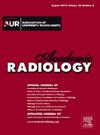PSMA PET vs. mpMRI for Lymph Node Metastasis of Prostate Cancer: A Systematic Review and Head-to-Head Comparative Meta-analysis
IF 3.8
2区 医学
Q1 RADIOLOGY, NUCLEAR MEDICINE & MEDICAL IMAGING
引用次数: 0
Abstract
Purpose
To compare prostate-specific membrane antigen (PSMA) PET with multiparametric MRI (mpMRI) in the diagnosis of lymph node metastasis (LNM) in prostate cancer.
Methods
A comprehensive search of PubMed, Embase, and Web of Science identified studies published up to August 24, 2024. Studies comparing PSMA PET and mpMRI accuracy in detecting LNM in prostate cancer were included. The quality of each study was assessed using the Quality Assessment of Diagnostic Performance Studies-2 tool.
Results
This study included 23 articles with a total of 3041 patients. The pooled analysis showed PSMA PET had a sensitivity of 0.74 (95% CI:0.62–0.85) and specificity of 0.96 (95% CI:0.93–0.98) for detecting prostate cancer LNM, while mpMRI had a sensitivity of 0.45 (95% CI:0.32–0.57) and specificity at 0.92 (95% CI:0.86–0.97). PSMA PET shows notably higher sensitivity than mpMRI, (P < 0.01) with no significant difference in specificity (P = 0.18). For initial staging, PSMA PET shows significantly higher sensitivity than mpMRI (P < 0.01), with no significant specificity difference (P = 0.17). Subgroup analysis showed that both [68Ga]Ga-PSMA-11 PET and [18F]F-PSMA-1007 PET had higher sensitivity than mpMRI (P = 0.03, P < 0.01) without significant differences in specificity (P = 0.10, P = 0.73). Meanwhile, there was no significant difference in the sensitivity (P = 0.20) and specificity (P = 0.43) of [18F]F-DCFPyL PET.
Conclusion
PSMA PET is more sensitive than mpMRI in detecting LNM in prostate cancer, especially for initial staging; however, there is no significant difference in specificity between the two. Due to the high heterogeneity, more subgroup-based studies are needed to standardize imaging practices and validate these findings.
PSMA PET与mpMRI对前列腺癌淋巴结转移的诊断:系统回顾和头对头比较荟萃分析。
目的:比较前列腺特异性膜抗原(PSMA) PET与多参数磁共振成像(mpMRI)对前列腺癌淋巴结转移(LNM)的诊断价值。方法:综合检索PubMed, Embase和Web of Science确定的截止到2024年8月24日发表的研究。比较PSMA PET和mpMRI检测前列腺癌LNM的准确性。每项研究的质量均采用诊断性能研究质量评估-2工具进行评估。结果:本研究纳入23篇文献,共3041例患者。合并分析显示,PSMA PET检测前列腺癌LNM的灵敏度为0.74 (95% CI:0.62-0.85),特异性为0.96 (95% CI:0.93-0.98), mpMRI检测前列腺癌LNM的灵敏度为0.45 (95% CI:0.32-0.57),特异性为0.92 (95% CI:0.86-0.97)。PSMA PET的灵敏度明显高于mpMRI, (p68ga]Ga-PSMA-11 PET和[18F]F-PSMA-1007 PET的灵敏度高于mpMRI (P = 0.03, p18f]F-DCFPyL PET)。结论:PSMA PET对前列腺癌LNM的检测比mpMRI更敏感,尤其是在前列腺癌的初始阶段;但两者在特异性上无显著差异。由于高异质性,需要更多基于亚组的研究来标准化成像实践并验证这些发现。
本文章由计算机程序翻译,如有差异,请以英文原文为准。
求助全文
约1分钟内获得全文
求助全文
来源期刊

Academic Radiology
医学-核医学
CiteScore
7.60
自引率
10.40%
发文量
432
审稿时长
18 days
期刊介绍:
Academic Radiology publishes original reports of clinical and laboratory investigations in diagnostic imaging, the diagnostic use of radioactive isotopes, computed tomography, positron emission tomography, magnetic resonance imaging, ultrasound, digital subtraction angiography, image-guided interventions and related techniques. It also includes brief technical reports describing original observations, techniques, and instrumental developments; state-of-the-art reports on clinical issues, new technology and other topics of current medical importance; meta-analyses; scientific studies and opinions on radiologic education; and letters to the Editor.
 求助内容:
求助内容: 应助结果提醒方式:
应助结果提醒方式:


